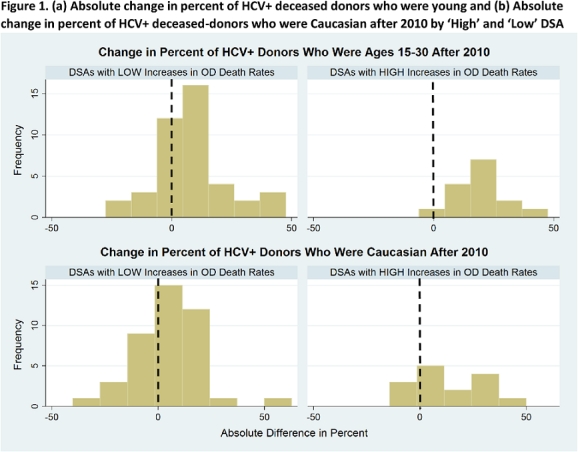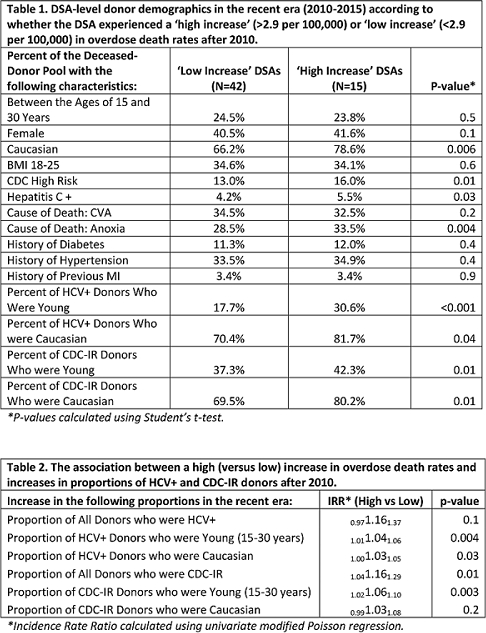Impact of the National Overdose Death Epidemic on the Deceased-Donor Pool.
JHU, Baltimore.
Meeting: 2016 American Transplant Congress
Abstract number: B90
Keywords: Donors, Hepatitis C, High-risk, marginal
Session Information
Session Name: Poster Session B: Donor Management: All Organs
Session Type: Poster Session
Date: Sunday, June 12, 2016
Session Time: 6:00pm-7:00pm
 Presentation Time: 6:00pm-7:00pm
Presentation Time: 6:00pm-7:00pm
Location: Halls C&D
Beginning in 2010, there was a dramatic increase in heroin and other opioid overdose(OD) deaths in several regions across the country, primarily among young Caucasians. We hypothesized that the epidemic may have impacted the landscape of deceased donors, particularly that of HCV+ and CDC Increased-Infectious Risk(CDC-IR) donors.
Methods: Using 2005-2013 CDC Multiple Cause of Death data and 2005-2015 OPTN data, we used modified Poisson regression to identify associations between increases in overdose death rates and shifts in donor demographics at the Donation Service Area(DSA) level, comparing rates in the early era(2005-2009) to the recent era(2010-2015). We categorized DSAs with an increase in OD death rates above 2.9 per 100,000 as 'high increase' DSAs, and those with an increase <2.9 per 100,000 as 'low increase' DSAs.
Results: After 2010, 15 DSAs experienced a 'high increase' in death rates from a mean of 12 to 17 per 100,000(p<0.001), and 42 DSAs experienced a 'low increase' from a mean of 12 to 13 deaths per 100,000. 'High increase' DSAs had higher proportions of donors who were HCV+, Caucasian, CDC-IR, and donors with anoxia as cause of death in the recent era(p<0.05). Furthermore, 'high' DSAs were more likely to have had an increase in the proportion of HCV+ donors ages 15-30 after 2010(IRR 1.011.041.06, p<0.01), and an increase in the proportion who were Caucasian(IRR 1.001.031.05, p<0.03). 'High' DSAs were also more likely to have had increases in the proportion of CDC-IR donors ages 15-30 after 2010(IRR1.021.061.10, p=0.003).
Conclusion: DSAs with significant increases in overdose death rates after 2010 have had increased availability of young, Caucasian HCV+ deceased donors and of young CDC-IR deceased donors. Evidence of the epidemic can be seen in the donor pool as availability of younger, healthier, and yet higher risk donors increases.


CITATION INFORMATION: Bowring M, Massie A, Kucirka L, Chow E, Sulkowski M, Segev D, Durand C. Impact of the National Overdose Death Epidemic on the Deceased-Donor Pool. Am J Transplant. 2016;16 (suppl 3).
To cite this abstract in AMA style:
Bowring M, Massie A, Kucirka L, Chow E, Sulkowski M, Segev D, Durand C. Impact of the National Overdose Death Epidemic on the Deceased-Donor Pool. [abstract]. Am J Transplant. 2016; 16 (suppl 3). https://atcmeetingabstracts.com/abstract/impact-of-the-national-overdose-death-epidemic-on-the-deceased-donor-pool/. Accessed December 22, 2025.« Back to 2016 American Transplant Congress
